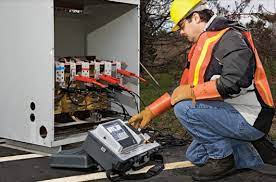Power flow study: what is it and what is it for?

During the design of the infrastructure of an electrical system, a study of power flows – carried out by a qualified team – guarantees that the processes and services will not be interrupted, due to the continuous flow of power through the system. Providing answers to a variety of questions related to power flow allows operations to proceed normally.
What is the study of power flows?
This is widely used in the operation and planning of a power system. It is a fundamental tool for the analysis of the latter.
In operations, the study of power flows is carried out to ensure that the generators reach their optimal operating capacity, maintenance can be carried out without problem and the power supply satisfies the demand satisfactorily. The analysis also determines how the system will operate under a specific load.
In theory, the study shows the mathematical description of an electrical network, as well as the calculations that reach satisfactory results.
For what do you use it?
The study of power flows is used to investigate:
- The components or the load of the circuit.
- Bus voltage profiles.
- Real and reactive power flow.
- Losses in the power system.
- Appropriate adjustments of the tap (faucet) of the transformer.
A system with this feature means maximizing the initial capital investment in the infrastructure and future operating costs.
What can the study do?
- Optimize the use of circuits.
- Develop practical voltage profiles.
- Minimize kW and kVAR losses.
- Develop guidelines for equipment specifications.
- Identify the tap configuration of the transformer.
How do you do it?
A power system consists of several nodes or buses in which lines, generators and loads are connected. Each bus has two power flow equations associated with it, which makes the analysis non-linear.
In a power flow study, two of the four variables – real potential, reactive power, voltage magnitude, and voltage angle – are defined, while the other two are unknown. In this way, the equation is equal to the number of missing variables. Those that are available depend on the type of bus in the analysis.
Bus types
- Load: calculates angle and magnitude, or collective voltage, while available values are reactive and actual power.
- Generator – Determines angle and reactive power, while known values are voltage and actual power.
Profits
- Reduce unplanned downtime.
- Reduce maintenance and operating costs.
- Get more capacity from existing assets.
It is also a tool that provides security to the workers of a facility, as it determines the best way to mitigate risks such as overloads.
Understanding an arc blast
In many cases, it occurs when a tool or conductive object passes close to electrical conductors. This blast can be extremely powerful, so it can launch all kinds of objects into the air at high speed. Even the pressure itself can result in significant damage to the human brain, organs, and other parts of the body. The event is distinctive by flashes that resemble an explosion. The strength of an arc blast will depend on how powerful the arc flash will be and the amount of pressure created.
Read more bloggater.com




